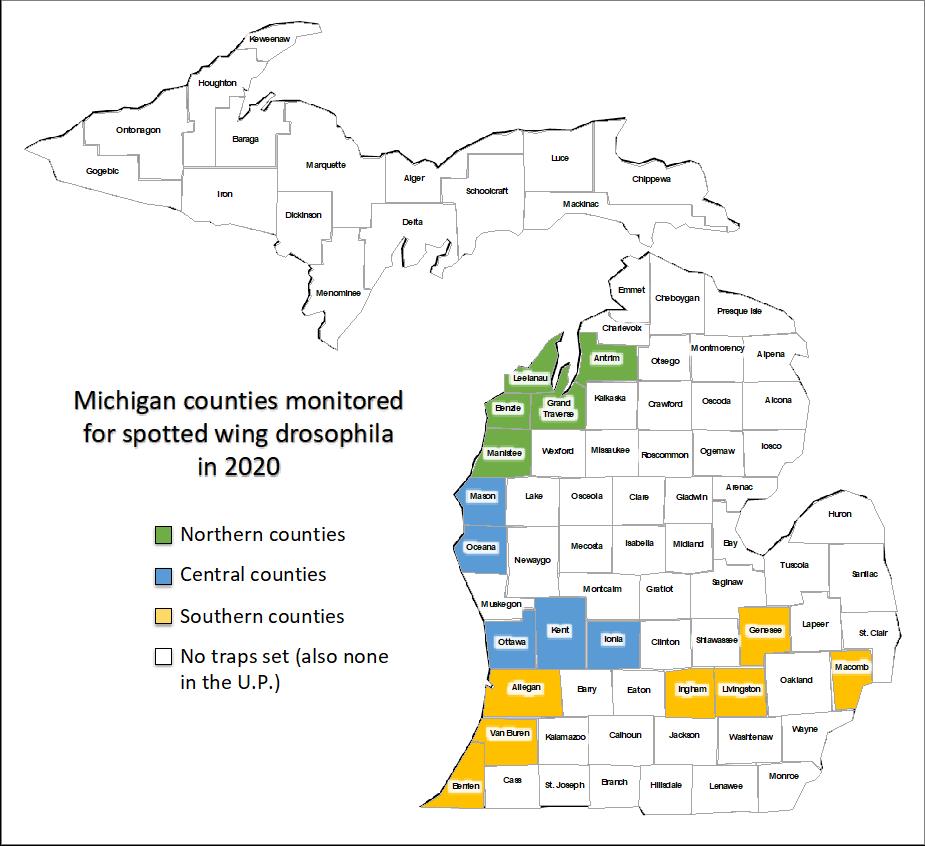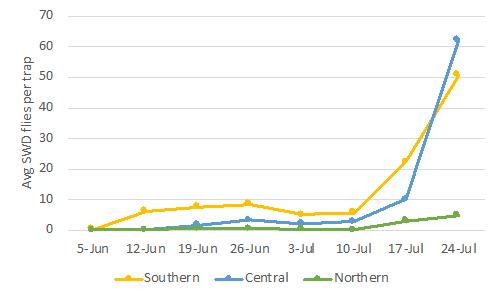Michigan spotted wing Drosophila update – July 28, 2020
Spotted wing Drosophila populations are surging. Growers must protect susceptible crops.

This year, Michigan State University Extension is monitoring for spotted wing Drosophila (SWD) activity in 17 counties (Figure 1) at over 90 sites that include vineyards, sweet and tart cherry orchards, and blueberry, raspberry and strawberry plantings. This report is the sixth and final report of the season, and week eight of our monitoring efforts.
The summer surge of SWD is in full swing (Figure 2). Rain events, humid weather, temperatures hovering at or below 90 degrees Fahrenheit, and wild hosts ripening in field margins all contribute to higher numbers of SWD at this time in the season. Unprotected blocks of ripening cherries and berries are at high risk of infestation by SWD larvae. This week, we found lots of fruit infested with SWD larvae in unmanaged blocks of both cherries and blueberries.


Berries
Ripening blueberries and summer raspberries and other thin-skinned berries must be protected against infestation at this time. For U-pick operations, following up with removal of overripe berries left behind is an essential sanitation practice to reduce local SWD pressure. In addition to the judicious use of insecticides, netting can be used to protect berry crops (see image above). Using netting will be presented this Friday, July 31, from 12-1 p.m. during the SWD Friday webinar series.
Cherries
With the exception of some northwest Michigan tart cherry orchards, cherry harvest is finished in most of Michigan. Any unprotected cherries remaining are at high risk of infestation.
Grapes
Grapes are beginning to ripen in southern Michigan. Details on how to manage SWD and other vinegar flies to minimize their role in sour rot in grapes will be presented during the SWD Friday webinar series on Aug. 14 from 12-1 p.m.
Managing SWD
Given how quickly this pest can reproduce and how devastating infestation can be, if your crop is at a susceptible stage, a cover spray of an insecticide that is rated excellent against this pest should be applied to protect fruit. Remember to rotate insecticide classes once you begin your spray program. Also keep in mind that some classes of insecticides wash off after rain events or when using overhead irrigation more readily than others or will be less effective under high heat conditions (e.g., some pyrethroids).
Most of the crop-specific management guides have been updated for the 2020 season and are available as free downloadable PDFs, including a guide for home gardens. For more information on effective insecticides registered for use to control SWD, refer to the MSU Extension Michigan Fruit Management Guide (E154).
Monitoring for SWD in fruit
Through the remainder of the season, it is essential to know whether an SWD management program is working to prevent infested fruit. Growers can determine how well their program is working by sampling fruit and using the salt test in the days prior to harvest. This practice provides the information growers need to understand their risk of infestation and to document that fruit are clean of any infestation by SWD. For details on the filter method described during the SWD Friday webinar series on July 10, check out this open-access article, “A Filter Method for Improved Monitoring of Drosophila suzukii (Diptera: Drosophilidae) Larvae in Fruit.”
Biological control and flowering habitat on fruit farms
Habitat near fruit plantings established for pollinators will also benefit natural enemies of fruit pests, including spotted wing drosophila. Local populations of parasitoids can take refuge and use nectar from flowering plants as a source of energy. For more information on SWD parasitoids and the work that has been done to find an efficient parasitoid of SWD, tune into the Aug. 7 edition of the SWD Friday webinar series from 12-1 p.m. For information on how to establish a wildflower planting on your fruit farm, download this free PDF: “Establishing Wildflower Habitat to Support Pollinators of Michigan Fruit Crops.”
Counties being monitored in 2020: Allegan, Berrien, Genesee, Ingham, Livingston, Macomb, and Van Buren in the south, Ionia, Kent, Mason, Oceana, and Ottawa in central Michigan, and Antrim, Benzie, Grand Traverse, Leelanau, and Manistee in the north.



 Print
Print Email
Email


